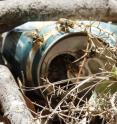The wasp that never cries wolf
European paper wasps (Polistes dominula) advertise the size of their poison glands to potential predators, finds a new study published in BioMed Central's open access journal Frontiers in Zoology. The brighter the colour, the larger the poison gland. Aposematism is used by many different animals to warn potential predators that they are poisonous. Usually this takes the form of distinctive colouration or patterns which predators quickly learn to avoid. Paper wasps have conspicuous yellow and black patterns covering their bodies and researchers from University of Granada and the University of Almería found that when they compared the size of a wasp's poison gland to the brightness of its colour there was a direct relationship.
Dr Gregorio Moreno-Rueda, who led this study explained, "It might be thought that bigger wasps have bigger poison glands, and this is indeed true, but even when the data was adjusted to take in to account the size of the insect, a positive correlation between gland size and brightness remained."
But producing both the poison and the distinctive colouration is costly to the wasp. To get around this problem some species, such as hoverflies, have learnt to mimic poisonous ones. But other animals use colouration as a truthful (Zahavian) signal. In this case the wasp would be signalling that it is so strong and healthy that it can waste energy producing bright colour; and a strong and healthy wasp will contain a lot of poison.
Dr Moreno-Rueda continued, "A second possibility is that the pigment is also an antioxidant that helps protect the insect from its own poison or from the by-products of poison production. Consequently an insect which has a lot of poison will also have a lot of colour."
Either way predators need to beware -- a bright wasp will leave a nasty taste in the mouth.
